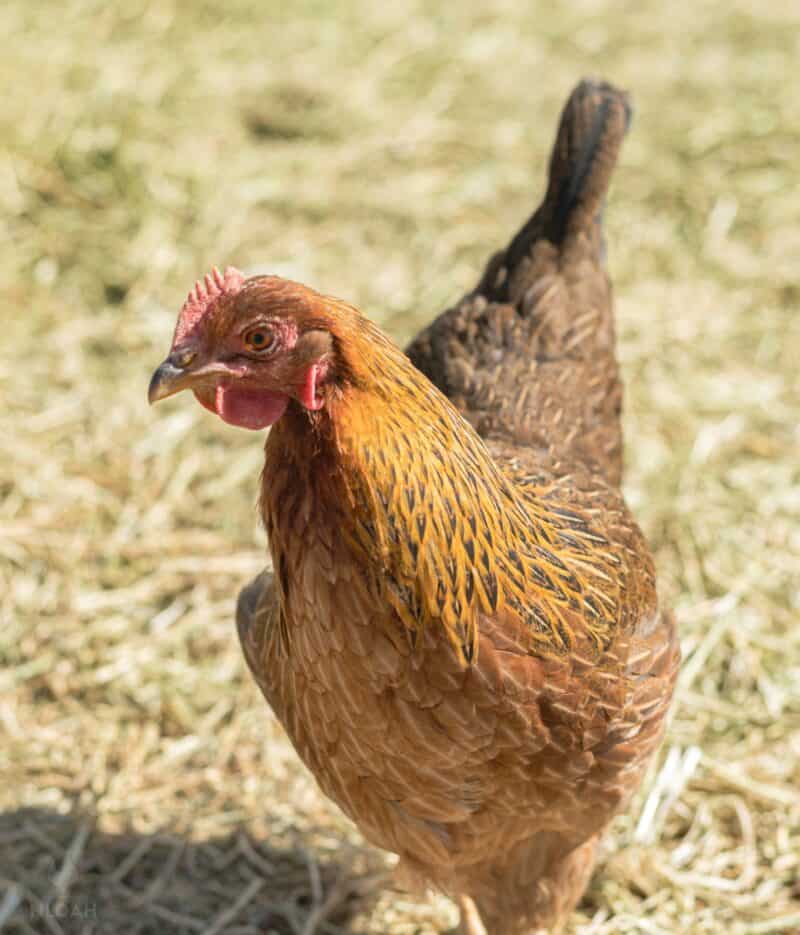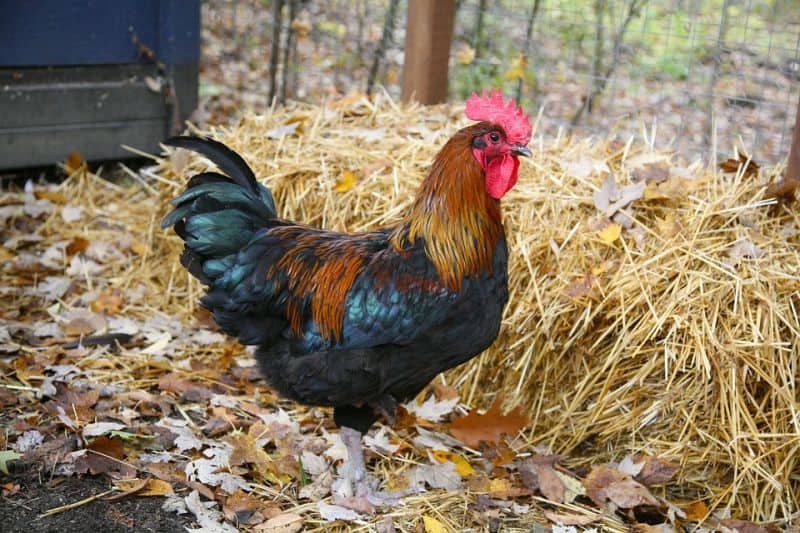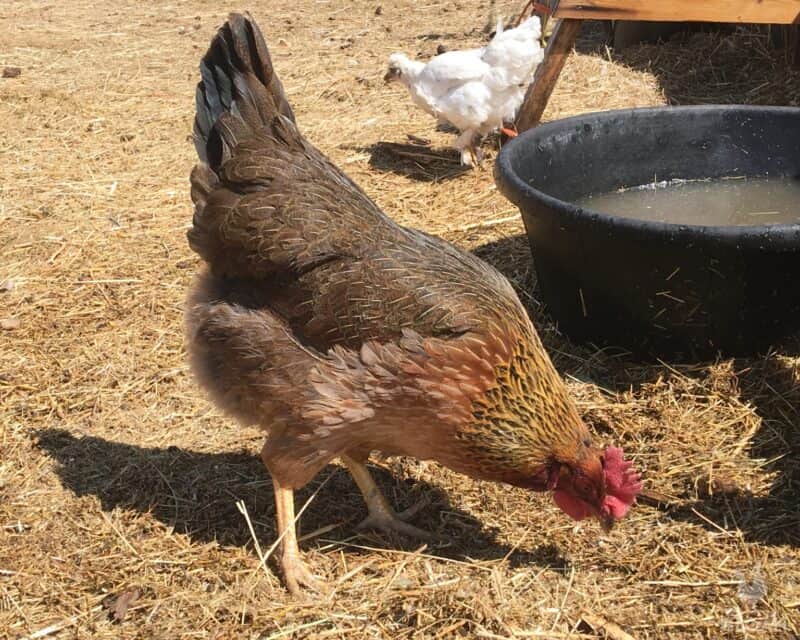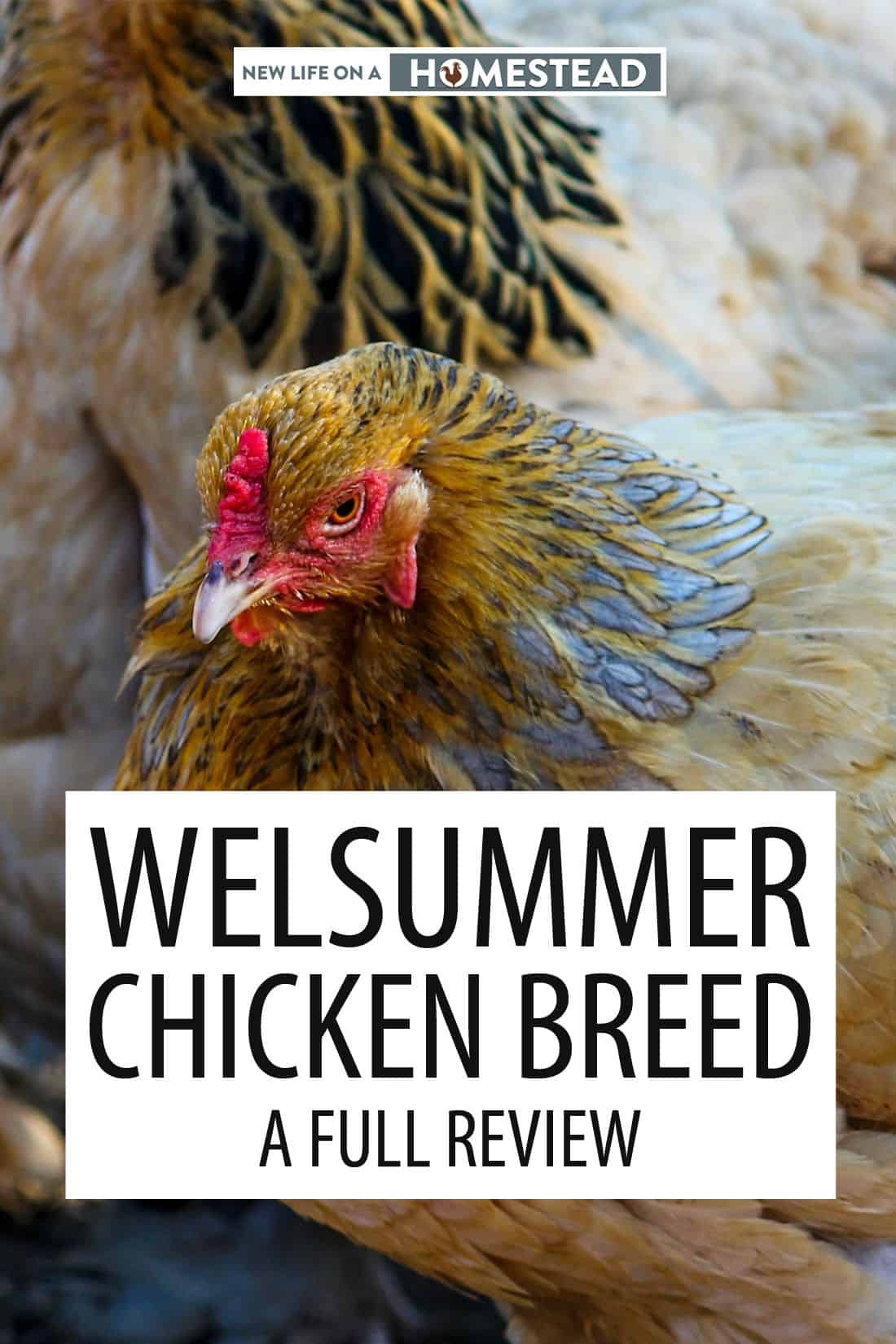Raising chickens is a great introduction to homesteading. My husband and I jokingly refer to chickens as “the gateway drug.” We started with a flock of two dozen birds, and since then, have grown to raising several hundred chickens (including meat birds and dedicated layers) each year.
When you think about popular chicken breeds, there are a few that always come to mind – Cornish Cross, White Leghorn, New Hampshire Red, and so on.

The Welsummer chicken breed, in my opinion, is a grossly underappreciated bird. Popular in Australia and the United Kingdom, Welsummer chickens haven’t gained quite as much traction in the United States – but for no good reason.
This chicken breed presents backyard chicken keepers with a whole host of benefits. I’ll give you a full overview of all of them (as well as tips on how to raise Welsummer chickens) in my Welsummer chicken breed review.
What is the Welsummer Chicken Breed?
The Welsummer chicken is a breed that is native to the Netherlands. The breed gets its name from the town of Welsum, where it was first developed.
The Welsummer is a dual-purpose chicken, meaning that it can be used for both eggs and meat. The hens are good egg-layers, and the roosters have a good amount of meat on their bones. The breed is also known for its striking plumage, which is a rich rusty brown color with dark copper highlights.
The Welsummer is an easy chicken to keep, and it does well in both hot and cold weather.
If you are looking for a chicken that is both productive and beautiful, then the Welsummer is a great choice.
History of the Welsummer Chicken Breed
Believe it or not, Welsummer chickens are relatively young as a breed, having only been around for about 100 years or so. They first came into existence in the Netherlands as a popular dual-purpose chicken breed during the post World War I era.
Home to many landrace varieties of chickens, the Netherlands was at the time considered somewhat of a hot spot as it related to chickens.
Many varieties have been bred since then. Named after the Dutch town of Welsum, the Welsummer chicken breed became so popular there that the town now has a statue of the bird to commemorate its creation.
The Welsummer is a conglomeration of multiple chicken breeds. Some are standard, while some were landrace, with Welsummer chickens containing genetics from partridge Leghorn, partridge Cochin, partridge Wyandotte, Rhode Island Red, and Barnevelder chickens.
Some people believe that Welsummer chickens may have some Brahma, Malay, and Croad Langshan genetics, too.
Whatever the case may be, Welsummer chickens are remarkably resilient, and a great choice for any backyard farm.
The chickens didn’t make their “Debut” until 1921, when they first appeared at the Hague’s World Poultry Congress. Here, the chicken was eagerly accepted into popular tradition by European poultry enthusiasts, with some of the first specimens coming to the United States in 1928.
What Are Welsummer Chickens Good For?
The Welsummer is a popular choice for backyard chicken keepers due to its distinctive appearance and good egg-laying abilities. The breed is known for its red plumage with dark brown markings, which gives it a unique speckled appearance.
In addition to being good egg-layers, Welsummer chickens are also known for their calm and docile temperament.
As a result, they make excellent pets as well as productive members of the homestead. Whether you’re looking for a pretty face or a dependable layer, the Welsummer chicken is sure to please.
What Do Welsummer Chickens Look Like?
Welsummer chickens are quite beautiful to behold. These birds have a partridge feather pattern, which makes sense given its genetics.
Most of its body is a dark brown in color with a few white or light brown feather shafts. It has neck feathers that are a rich golden brown with dark brown shading, providing the chicken with a golden mantle.
Roosters look quite different from hens. They have saddle feathers and hackles that are a deep chestnut in color and free-flowing in nature. Unique, the sickles, chest, and under feathers of this bird are all an iridescent green.

As a single comb bird, “pure” Welsummer chickens should have five points to the comb, and everything, from the comb to the earlobes and the wattles, should be red.
Welsummers have horn and black colored beaks along with yellow shanks and skin. Each foot has four toes and the eyes are a red-bay color.
These chickens aren’t the largest you can raise, but they’re far from being the smallest. Hens usually weigh around six pounds, while roosters tip the scales at seven or eight. They have full breasts, and an upright posture.
Although the Dutch standard for the Welsummer chicken breed was set in 1924, Americans did not admit the breed to the American Poultry Association until 1991.
Here, they are classified as a Continental Breed. The only recognized variety is partridge. However, there are also gold and silver duckwing varieties out there.
There is also a recognized bantam breed of this chicken. If you’ve ever raised bantams, you probably know that the key difference between a standard and a bantam is the size.
Bantams lay lighter colored eggs, and are single-combed. Otherwise, despite being substantially smaller than their standard counterparts, bantam Welsummers look more or less the same.
What Colors Do Welsummer Chickens Come In?
Welsummer chickens come in a variety of colors, including golden brown, light brown, dark brown, and red.
The most common color is golden brown, followed by light brown. Dark brown and red Welsummer chickens are less common but can still be found in certain parts of the world.
Though they come in a variety of colors, all Welsummer chickens have feathers that are tipped with a darker shade, giving them a unique “speckled” appearance.
Behavior of Welsummer Chickens
Welsummer chickens are calm, docile, friendly, and incredibly intelligent. They aren’t known for being territorial, nor are they overly aggressive with other breeds.
If you are already raising a flock of backyard chickens, you probably don’t have to worry about introducing Welsummers to the mix.
Unlike some chicken breeds, like New Hampshires, who can be a bit aggressive or pushy with food, these chickens will mostly keep to themselves.
That being said, they don’t usually fall to the bottom of the pecking order, either. They are usually right around the middle of the mix, not likely to be bullied but not likely to be the main offenders, either.
Welsummers, however, can be incredibly loud. They will raise a lot of ruckus whenever the mood strikes them, often calling out for no reason at all.
They are good foragers, and will do a nice job of finding their own food when allowed to free range. They also are not excellent flyers, making them easy to contain if you don’t wish to allow them to free range all over the neighborhood.
Although it’s a good idea to erect some kind of fence to keep them out of your neighbors’ lawns, you don’t have to worry about building the fence too tall or too secure to keep them in.
Welsummers do well in both warm and cool weather, provided that they have decent shelter. Native to Europe and used to the colder winters there, they do best in colder climates but can thrive in hotter environments when given some shade.
Welsummer Egg Laying and Temperament?
Welsummer chickens are decent egg producers. As with most dual purpose breeds, Welsummers aren’t the best egg producers you’ll find, and they aren’t the best meat producers, but they offer a great compromise between the two if you only want to raise one breed of chicken.
On average, a Welsummer hen will lay anywhere between 160 to 250 eggs per year. If that seems like a lot of variation, it is, and it’s likely due to the fact that there are so many component breeds that make up the Welsummer’s unique genetic background. You never quite know what you are going to get.
However, on average, a Welsummer will lay around four eggs per week during its prime laying age and at the peak of summer. They tend to slow or stop egg production entirely during the winter months, but should start back up once the springtime arrives.
The eggs are known for being quite stunning. They are a rich, deep brown, often with dark speckles. The pigmentation is so rich and beautiful that you sometimes might find yourself removing it from the eggs when you clean them!
Unfortunately, Welsummers are not unknown for going broody very often, and they also aren’t the best of mothers. Therefore, you will want to rely on other methods, like using an incubator, if you want to raise chicks on your farm.
One unique feature of Weslummer chicks, however, is that they are autosexing. You will be able to tell the difference between a rooster and a hen when it hatches because the two genders have such distinct appearances.
Are Welsummer Chickens Good For Meat?
Welsummers are commonly raised in other countries for the quality of their meat, but they haven’t quite caught on in the United States as of yet. They have a good quality carcass that is, on average, around three to four pounds at sixteen weeks (for cockerels).
You won’t have to raise them quite as long as other meat birds, but they won’t be the largest, either – that is more or less the case with all dual purpose chicken breeds.
However, as a heritage breed, it will be hard for you to find anything that comes close to comparing to the quality of Welsummer chicken meat. The meat from these birds is rich and flavorful with a good proportion of white to dark meat.
Health Considerations of Welsummer Chickens
There are very few issues you need to take into consideration when it comes to raising Welsummer chickens. They aren’t prone to many health problems that you won’t find with other chicken breeds, although it’s always a good idea to keep an eye out for things like internal and external parasites.
They are hardy and robust, and don’t usually suffer from age-related heart or muscle issues, as some larger chicken breeds do.
You do need to keep an eye out for frostbite in the wintertime. This will only strike the large wattles and combs of these birds, and it’s not fatal or even a major health concern to worry about if it does.
However, it can make your chickens uncomfortable and lead to other health issues if left untreated (for example, the tissue there can completely die).
To prevent it, make sure you keep your chickens in a warm, well-ventilated coop (you do not need to heat it, but make sure moisture has a way to escape – chickens release a lot of moisture as they breathe in their sleep at night!).
On especially cold nights, you can dab a bit of Vaseline on the combs and wattles of your birds – roosters will be especially susceptible. Making sure your stocking density is up to par for the size of your coop can help them stay warm, too.
Besides that, Welsummers are tough chickens that aren’t prone to very many health problems. Feed them the proper diet and give them plenty of room to roam, and they’ll live naturally until around nine years of age (unless you use them for meat before that point).
Benefits of Raising Welsummer Chickens
In addition to all the benefits mentioned above, there are a few other reasons why you might want to raise Weslummer chickens.
For starters, the eggs! They may not be the most prolific egg layers, but if you really want that beautiful palette of colors in your morning egg basket, the Weslummer is a bird you are going to want to add to your flock. There’s nothing quite like those gorgeous terra cotta eggs.
Since these chickens dress out at a respectable weight, you can also easily raise them for meat without having to spend a ton of money. They are great foragers, so they will do a great job of filling in the gaps in your feed budget.
As long as they have plenty of room to free range, they will eat most of their fill on garden morales so that you don’t have to provide them with a ton of grain.
Welsummers are self-sufficient birds and, while they aren’t necessarily the smartest in the flock, they are relatively wiley.
In fact, people who raise them claim that they are better at staying away from predators as their dull coloring helps camouflage them from any ground- and aerial-based predators.
These chickens are friendly and approachable so you don’t have to worry about being attacked every time you go in the coop. They are suitable for people with small children, other chickens, or other pets.

Caring for Welsummer Chickens
Welsummer chickens are a heritage breed that is known for its distinctive reddish-brown plumage. The breed is hardy and adaptable, and it does well in a variety of climates.
However, like all chickens, Welsummers require some basic care in order to stay healthy and productive. Here are some tips for caring for Welsummer chickens.
What Do Welsummer Chickens Eat?
Welsummer chickens should have a balanced diet that includes plenty of fresh vegetables and fruits, as well as some high-quality chicken feed. It’s important to give your Welsummer chickens access to plenty of fresh water, as they tend to drink a lot.
You can also offer your chickens some scratch grains and grit to help with their digestive system.
Overall, feeding Welsummer chickens is not too different from feeding other types of chickens. Just make sure to provide a healthy and balanced diet, and you’ll be sure to have happy and healthy chickens!
Health Concerns
Although Welsummer chickens are generally healthy, there are a few health concerns that owners should be aware of.
One such concern is Marek’s disease, which is a viral infection that can cause paralysis and even death in chickens. Another concern is coccidiosis, which is a protozoal infection that can lead to diarrhea and weight loss.
Both of these health concerns are relatively rare in Welsummer chickens, but it is still important for owners to be aware of them. In addition, Welsummer chickens are prone to CHICKENpox, which is a viral disease that causes mild respiratory symptoms.
However, this disease is not dangerous to humans and can easily be treated with antiviral medication.
Predator Problems with Welsummer Chickens
One common predator problem that can occur with Welsummer chickens is foxes and other predators attacking the coop at night. To help mitigate this, it’s important to take a few precautions.
First, make sure the coop is well-built and sturdy, with no gaps or openings that a fox could squeeze through. Second, consider installing a motion-activated light near the coop, which will startle predators and make them more likely to avoid the area.
Finally, keep the chickens’ outdoor area clean and free of potential hiding places for predators. By taking these steps, you can help to reduce the risk of your Welsummer chickens being attacked by predators.
Housing Welsummer Chickens
When it comes to housing Welsumer chickens, there are a few things to keep in mind. First, the birds need plenty of space to stretch their wings and move around.
Second, the coop should be well-ventilated to prevent the build-up of ammonia fumes. Third, the coop should be located in a safe area away from predators.
Challenges of Raising Welsummer Chickens
There are very few reasons not to raise Welsummer chickens – except for the fact that they aren’t the most common ones you’ll see for sale at your local farm and garden supply store.
However, if you’re expecting an egg every day or just about every day, that would be one reason not to choose this breed.
Although they do lay a respectable number of eggs, you aren’t going to get as much egg production out of a Weslummer as you would a White Leghorn, Golden Comet, or similar hybrid.
They are friendly, but don’t necessarily love being picked up and played with. If you only want to raise chickens as your pets, then Welsummers might not be the best choice. They are not lap chickens by any means.
Finally, remember that Welsummer chickens are not the best mothers. If you want to raise your own chicks, you will need to hatch eggs by using a foster hen to sit on the eggs for you or by using an incubator.
Where to Find Welsummer Chickens For Sale
As with most chicken breeds, you can find Welsummer chickens for sale at most online hatcheries. These birds aren’t quite as common as others, like Rhode Island Reds or White Leghorns, so you may have to do some searching in order to find the best price.
Your local farm and garden supply might not have them in stock as they would other birds during the springtime chick rush, but often, they can order them for you.
Check around with local breeders and take some time to visit any farms near you where Welsummers are raised. This will give you the opportunity to make sure your birds were raised in the healthiest conditions and are from the best breeding stock possible.
Is the Welsummer Chicken Right for You?
If you’re looking for a chicken that lays large, dark brown eggs and has a handsome coloring, the Welsummer may be the breed for you.
However, there are a few things to consider before adding this breed to your flock. The first is that Welsummers are known for being shy and skittish around other chickens, so they may not do well in a mixed flock. They also tend to be fairly slow-growing, so if you’re looking for chickens that will start laying quickly or dress out quickly for meat, this isn’t the best breed.
With that said, Welsummers are hardy birds that do well in both hot and cold weather, and they make excellent watchdogs. So if you’re looking for a beautiful bird with plenty of personality, the Welsummer may be right for you.
Raising Welsummer chickens is not difficult, particularly not when compared to other breeds of chickens. In fact, the most difficult part of raising Welsummers will likely just be finding a place to buy them!
However, once you’re able to source a few chicks for your backyard flock, I can guarantee that you’ll be glad you did.
Frequently Asked Questions
Welsummers are considered to be good chickens for a variety of reasons. One reason is that they are good egg-layers. Welsummers typically lay around 200 eggs per year, which is more than many other breeds of chicken.
Additionally, Welsummers are known for being relatively docile and easy to handle, making them a good choice for people who are new to keeping chickens. They are also known for being good foragers, which means they can help to control insect populations in your garden or yard.
The Welsummer bantam is a popular choice for backyard chicken keepers due to its friendly personality and egg-laying ability.
This breed is also known for being good egg-layers, with most hens producing between 150 and 200 eggs per year. However, there can be some variation in egg production from bird to bird, with some hens laying closer to 300 eggs per year.
Welsummer chickens are a popular choice for backyard chicken enthusiasts, and for good reason. These birds are not only beautiful to look at, but they’re also excellent layers. In fact, it’s not uncommon for a Welsummer hen to lay up to 280 eggs per year. That’s nearly one egg per day!
Additionally, Welsummer eggs are large and dark brown, making them perfect for baking and other culinary uses. If you’re looking for a chicken that can provide you with plenty of fresh eggs, then the Welsummer is a great choice.
The answer can vary somewhat based on the individual chicken, but most Welsummer chickens will start laying eggs at around 18 to 20 weeks of age.
However, it’s important to keep in mind that egg production can be impacted by factors such as disease, stress, changes in the weather, and the amount of daylight. As a result, it’s not unusual for there to be some variation in when Welsummer chickens start laying eggs.
While the breed standard for Welsummer chickens specifies that the eggs should be a dark brown color, there is some variation in the shade of brown that these birds can produce.
Some Welsummer chickens may lay eggs that are closer to black, while others may lay eggs with a more reddish tint. However, all Welsummer chickens lay eggs that are significantly darker than the average chicken egg.
When it comes to temperament, Welsummer chickens are relatively calm and docile. They enjoy human interaction and can quickly become socialized pets.
However, like all chickens, they can be skittish around loud noises or sudden movements, as well as around chickens of other breeds.
Today, Welsummer chickens are still prized for their brown eggs, but they are also gaining popularity as a meat bird.
Thanks to their sturdy build and good foraging ability, Welsummers make excellent free-range chickens. They also tend to reach butchering weight at a young age, making them ideal for those looking to raise chickens for meat.
Adult roosters usually weigh around 8 pounds, while hens usually weigh around 6 pounds. Roosters can be distinguished from hens by their larger size, brighter plumage, and longer tails. Additionally, roosters typically have a larger comb and wattles than hens.
The Welsummer chicken is characterized by its reddish-brown plumage, which is flecked with black and white. The breed is also known for its large brown eyes and single comb. The Welsummer chicken is a popular choice for backyard chicken coops because of its docile nature and egg-laying ability.

last update: 07/15/2022 by Rebekah Pierce

Rebekah is a high-school English teacher n New York, where she lives on a 22 acre homestead. She raises and grows chickens, bees, and veggies such as zucchini (among other things).

The top picture is a Blue Laced Buff Brahma, not a Welsummer. Great post on Welsummers though!
They are beautiful chickens! I have never heard of the breed. At one time I had 20 red “sex-links” chickens and 1 same breed rooster. They were half Rhode Island Reds. We were happy with the egg production but they are rather small for meat birds. They were smart and friendly and we enjoyed having them. I would have chickens again in a flash, if circumstances permitted.